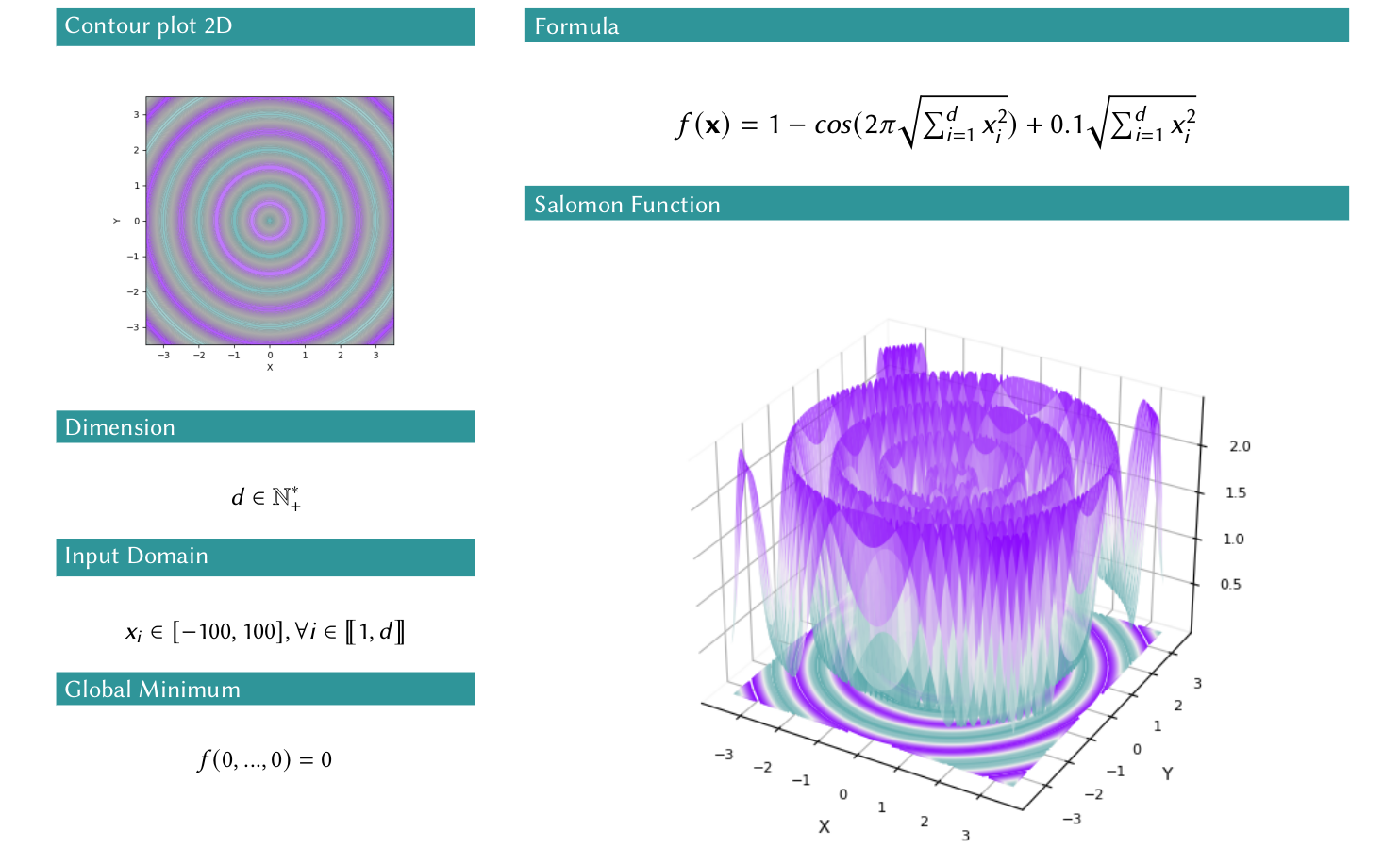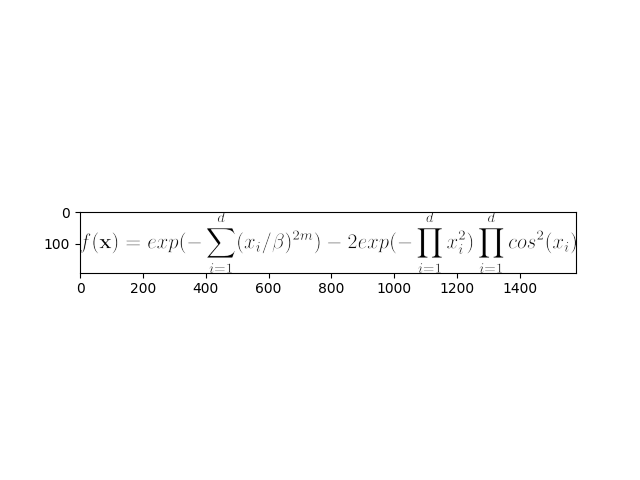Here a repository where you can find and easy access python implementation of a benchmark of functions to challenge single objective optimizations. You can download or fork the repository freely. If you see a mistake you can send me a mail at axel.arcueil@gmail.com or contact me on LinkedIn.
You can find the full documentation on this article
All the functions are describe as you can see on the image above.
- Ackley Function
- Ackley N. 2 Function
- Ackley N. 3 Function
- Ackley N. 4 Function
- Adjiman Function
- Alpine N. 1 Function
- Alpine N. 2 Function
- Bartels Conn Function
- Beale Function
- Bird Function
- Bohachevsky N. 1 Function
- Bohachevsky N. 2 Function
- Bohachevsky N. 3 Function
- Booth Function
- Branin Function
- Brent Function
- Brown Function
- Bukin N. 6 Function
- Cross-in-Tray Function
- Colville Function
- De Jong N. 5 Function
- Deckkers-Aarts Function
- Dixon-Price Function
- Drop-Wave Function
- Easom Function
- Egg Crate Function
- Eggholder function
- Exponential Function
- Forrester Function
- Goldstein-Price Function
- Gramacy & Lee Function
- Griewank Function
- Happy Cat Function
- Himmelblau Function
- Holder-Table Function
- Keane Function
- Langermann Function
- Leon Function
- Levy N. 13 Function
- Matyas Function
- McCormick Function
- Michalewicz Function
- Periodic Function
- Perm Function 0, d, β
- Perm Function d, β
- Powell Function
- Qing Function
- Quartic Function
- Rastrigin Function
- Ridge Function
- Rosenbrock Function
- Rotated Hyper-Ellipsoid Function
- Salomon Function
- Schaffer N. 1 Function
- Schaffer N. 2 Function
- Schaffer N. 3 Function
- Schaffer N. 4 Function
- Schwefel Function
- Schwefel 2.20 Function
- Schwefel 2.21 Function
- Schwefel 2.22 Function
- Schwefel 2.23 Function
- Shekel Function
- Shubert Function
- Shubert N. 3 Function
- Shubert N. 4 Function
- Six-Hump Camel Function
- Sphere Function
- Styblinski-Tank Function
- Sum Squares Function
- Three-Hump Camel Function
- Thevenot Function
- Trid Function
- Wolfe Function
- Xin-She Yang Function
- Xin-She Yang N. 2 Function
- Xin-She Yang N. 3 Function
- Xin-She Yang N. 4 Function
- Zakharov Function
import pybenchfunction as bench
# get all the available functions accepting ANY dimension
any_dim_functions = bench.get_functions(None)
# get all the available continuous and non-convex functions accepting 2D
continous_nonconvex_2d_functions = bench.get_functions(
2, # dimension
continuous=True,
convex=False,
separable=None,
differentiable=None,
mutimodal=None,
randomized_term=None
)
print(len(any_dim_functions)) # --> 40
print(len(continous_nonconvex_2d_functions)) # --> 41# set the dimension of the input for the function
sphere = bench.function.Sphere(3)
# get results
X = np.array([1, 3, 0])
print(sphere(X)) # --> 10# Warning ! Only working on 2d functions objects !
# Warning 2! change n_space to reduce the computing time
thevenot = bench.function.Thevenot(2)
bench.plot_2d(thevenot, n_space=1000, ax=None)
bench.plot_3d(thevenot, n_space=1000, ax=None)print(thevenot.get_param()) # --> {'m': 5, 'beta': 15}
thevenot.beta = 42
print(thevenot.get_param()) # --> {'m': 5, 'beta': 42}X_min, minimum = sphere.get_global_minimum(3)
print(X_min) # --> [0 0 0]
print(minimum) # --> 0latex = bench.function.Thevenot.latex_formula
# latex = bench.function.Thevenot.latex_formula_dimension
# latex = bench.function.Thevenot.latex_formula_input_domain
# latex = bench.function.Thevenot.latex_formula_global_minimum
print(latex) # --> f(\mathbf{x}) = exp(-\sum_{i=1}^{d}(x_i / \beta)^{2m}) - 2exp(-\prod_{i=1}^{d}x_i^2) \prod_{i=1}^{d}cos^ 2(x_i)
latex_img = bench.latex_img(latex)
# convert the latex formula to image
plt.imshow(latex_img)
plt.show()All the functions are Classes implemented in the same way. Here the Sphere example:
class Sphere:
name = 'Sphere'
latex_formula = r'f(\mathbf{x})=\sum_{i=1}^{d} x_i^{2}'
latex_formula_dimension = r'd \in \mathbb{N}_{+}^{*}'
latex_formula_input_domain = r'x_i \in [-5.12, 5.12], \forall i \in \llbracket 1, d\rrbracket'
latex_formula_global_minimum = r'f(0, ..., 0)=0'
continuous = True
convex = True
separable = True
differentiable = False
mutimodal = False
randomized_term = False
parametric = False
@classmethod
def is_dim_compatible(cls, d):
assert (d is None) or (isinstance(d, int) and (not d < 0)), "The dimension d must be None or a positive integer"
return (d is None) or (d > 0)
def __init__(self, d,):
self.d = d
self.input_domain = np.array([[-5.12, 5.12] for _ in range(d)])
def get_param(self):
return {}
def get_global_minimum(self, d):
X = np.array([0 for _ in range(d)])
return (X, self(X))
def __call__(self, X):
d = X.shape[0]
res = np.sum(X**2)
return res


